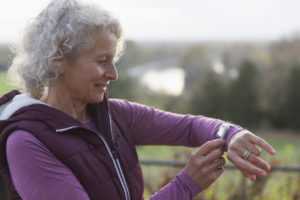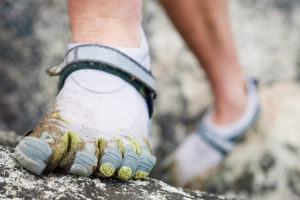Walking
Are 10,000 Steps Necessary?
Are some of your clients obsessed with achieving their step counts every day? While 10,000 steps is a popular marker, it turns out that taking as few as 4,400 steps per day is associated with a lower risk of death for women with a mean age of 72 years.
“Clearly, even a modest number of steps was related to lower mortality rate among these older women,” said principal investigator I-Min Lee, MBBS ScD, at Brigham and Women’s Hospital in Boston.
Minimalist Shoes and Stronger Foot Muscles
Minimalism is trending in many areas of life, including athletic shoes, with many fans touting numerous benefits. But does the evidence support the hype? Yes, according to research findings published in Medicine & Science in Sports & Exercise (2018; doi:10.1249/MSS.0000000000001751). Walking in minimalist shoes is as effective as foot-strengthening exercises and may result in better compliance than doing specific exercises.
How Fast You Walk May Affect How Long You Live
Want to outwalk the grim reaper? Pick up the pace, say researchers. A new study from the United Kingdom suggests that quicker walking may add years to your life.
The study’s primary aim was to examine the impact of walking pace and volume on all-cause mortality. To determine this, researchers looked at mortality records for 50,225 individuals from Scotland and England who had self-reported their walking data via interview.
The Long-Term Benefits of Pedometer Use
Studies show that tracking daily steps with a pedometer leads to higher activity levels. A new report out of the U.K. suggests the practice can inspire people to take more steps for many years.
The report included data from two separate 12-month studies; one involved inactive adults aged 45–75, while the other featured older adults aged 60–75. In the first, participants were assigned to one of three 12-week pedometer-based interventions—consultation with a nurse, support by mail or no consultation. In the second, there was no mail support group.
Activity Tracker Usage Improves
The initial finding—that people stop using their fitness trackers after the first 6 months—seems to be evolving. In a new study by insurance company Humana, 80% of participants in a structured program were still using activity trackers after 6 months. Researchers at the Perelman School of Medicine at the University of Pennsylvania in Philadelphia found that game design elements—such as points, levels, badges and financial incentives—helped to keep users active.
Walking Speed: A Predictor of Functional Health
Slow walking speed has been linked to a greater risk of mortality in older adults, while brisk walking has been linked to better health.
Spotting and Fixing Flaws in Walking Biomechanics
Participating in a program of regular exercise is a good idea at any stage of life, but particularly as we get older. Exercising frequently and consistently has many documented benefits, including promoting good health, preventing disease, enhancing mental health and physical capacity, aiding recovery from injury and illness, minimizing the effects of aging, and improving one’s ability to handle the physical demands of life (Bird, Smith & James 1998).
A New Way to Combat High Blood Pressure During Menopause
Researchers have linked menopause with arterial stiffness and high blood pressure. A recent study of Korean women, led by The North American Menopause Society, suggests that taking the stairs is a good way to manage those conditions.
4,000 Steps a Day for Brain Fitness
By walking more than 4,000 steps a day, adults aged 60 and older can improve both attention and mental skills, according to a study in the Journal of Alzheimer’s Disease (2017; doi:10.3233/JAD-170586).
University of California, Los Angeles, researchers examined the relationship between physical activity and cognitive function in nondemented older adults with memory issues. For 2 years, researchers tracked the number of daily steps taken by 26 older adults and conducted neuropsychological tests and MRI scans to measure thickness of brain structures.
Green Exercise: How It Benefits You
Here’s a look at what the latest findings tell us about why you may want to incorporate green exercise into your programs.
Taking the Right Step—Walking Research for the Ages
Have you ever heard clients say that “walking doesn’t count” as exercise? The truth is that walking can be a valuable part of your clients’ wellness routines—but how those steps fit into a whole program may depend on age. Two different studies offer valuable feedback on the benefits of walking through a workout.
STUDY #1: When Walking and Weight Loss Are in Step
Any Kind of Physical Activity Reduces Mortality Rates
Plenty of research encourages hitting the gym or going for a run as a means of keeping the grim reaper at bay. It turns out that any kind of physical activity—whether it’s achieved at the gym or at work—has protective benefits, according to a study produced by the Population Health Research Institute at McMaster University in Hamilton, Ontario.
Get Up, Stand Up—For Your Health
We know that sitting long hours is a health hazard that can lead to early death. What’s been unclear is whether frequent breaks in sit time can reduce that risk even if total sit time remains the same. Researchers from Columbia University Medical Center looked into that question.
Move 3 for Every 30
With most U.S. adults sitting 9–12 hours daily and the risks of inactivity becoming more apparent, the popular press and the scientific community concur that “sitting is the new smoking.” Indeed, there is mounting evidence linking sedentary lifestyles to cardiovascular diseases and all causes of mortality (Diaz et al. 2017).
Though the threat seems clear, one major question has puzzled researchers: Can people reduce their risks by taking short breaks in otherwise long periods of sitting still?
Happiness Is Found on the Hiking Trail
The next time someone tells you to take a hike, why not heed the suggestion! A new report says outdoor mountain hiking has many significant benefits.
Dogs Help Older Adults Move More
Dogs aren’t just man’s best friend; they also make for great activity partners. According to a new study, older adults with a canine friend spend lots more time walking than those who don’t own a dog.
The Smart Way to Move
Clients and attendees want to see results, and you want this, too. However, you’re with them a limited number of hours per week; you have little control over what they do when they’re not with you. What if you could provide additional tools that would help people reach their physical goals while also helping them make new neural connections?
Is Exercise an Ineffective Tool for Weight Management?
Being physically active is a primary way to lose or manage weight—right? And sedentary behavior is largely to blame for
current rates of obesity? Well, let's slow down. Findings from
a study conducted at Loyola University Chicago challenge both those statements.
Too Much Sitting Accelerates Aging, Dementia Risk
Scientists have linked extended bouts of sitting with increased risk of heart disease; certain types of cancers; pain and injury; early mortality; and more. Two new studies add to the long list of potential risks associated with sitting too long.
Older Adults Will Walk for Money, Charity
Want to motivate older adults to move more? Try offering them financial or charitable-giving incentives.


















